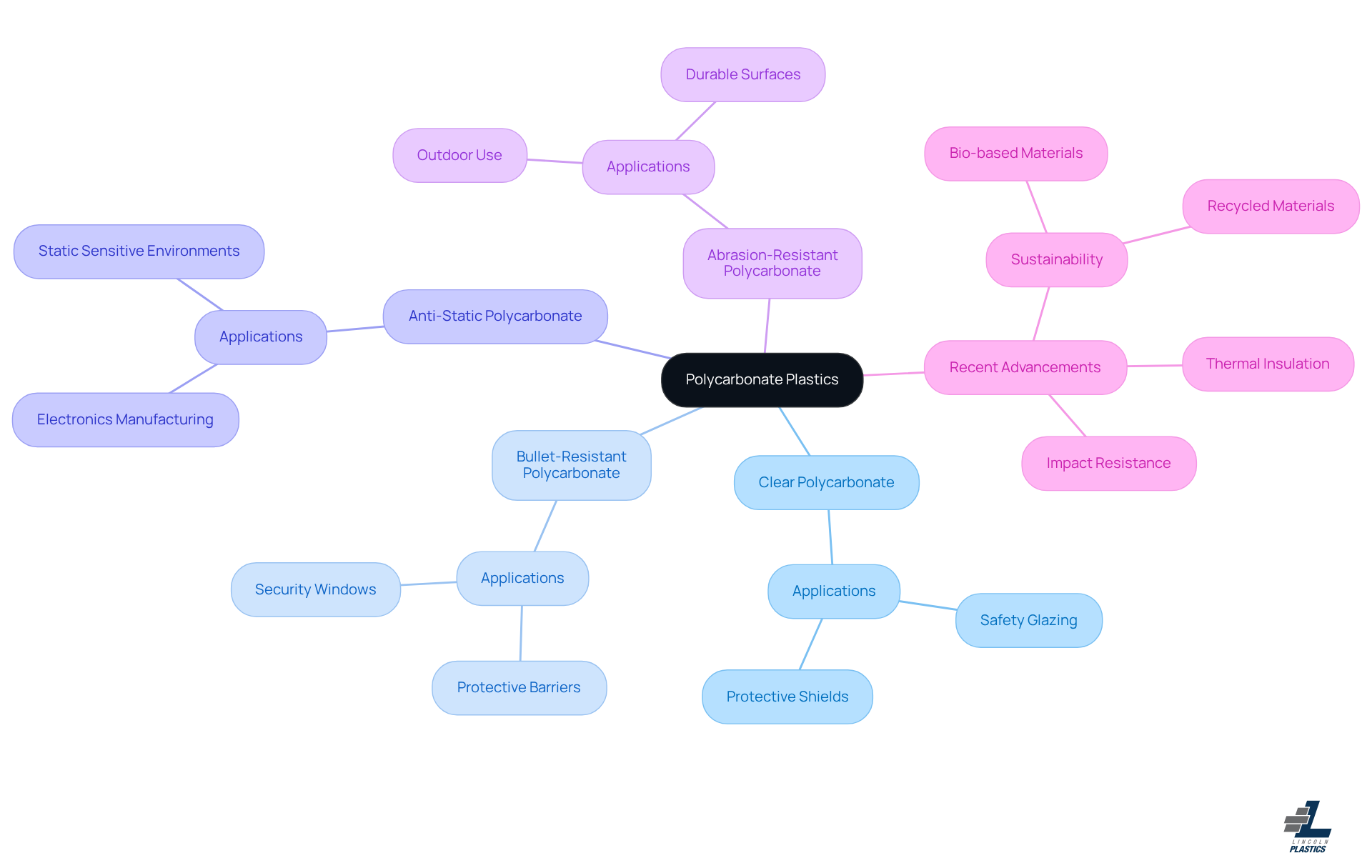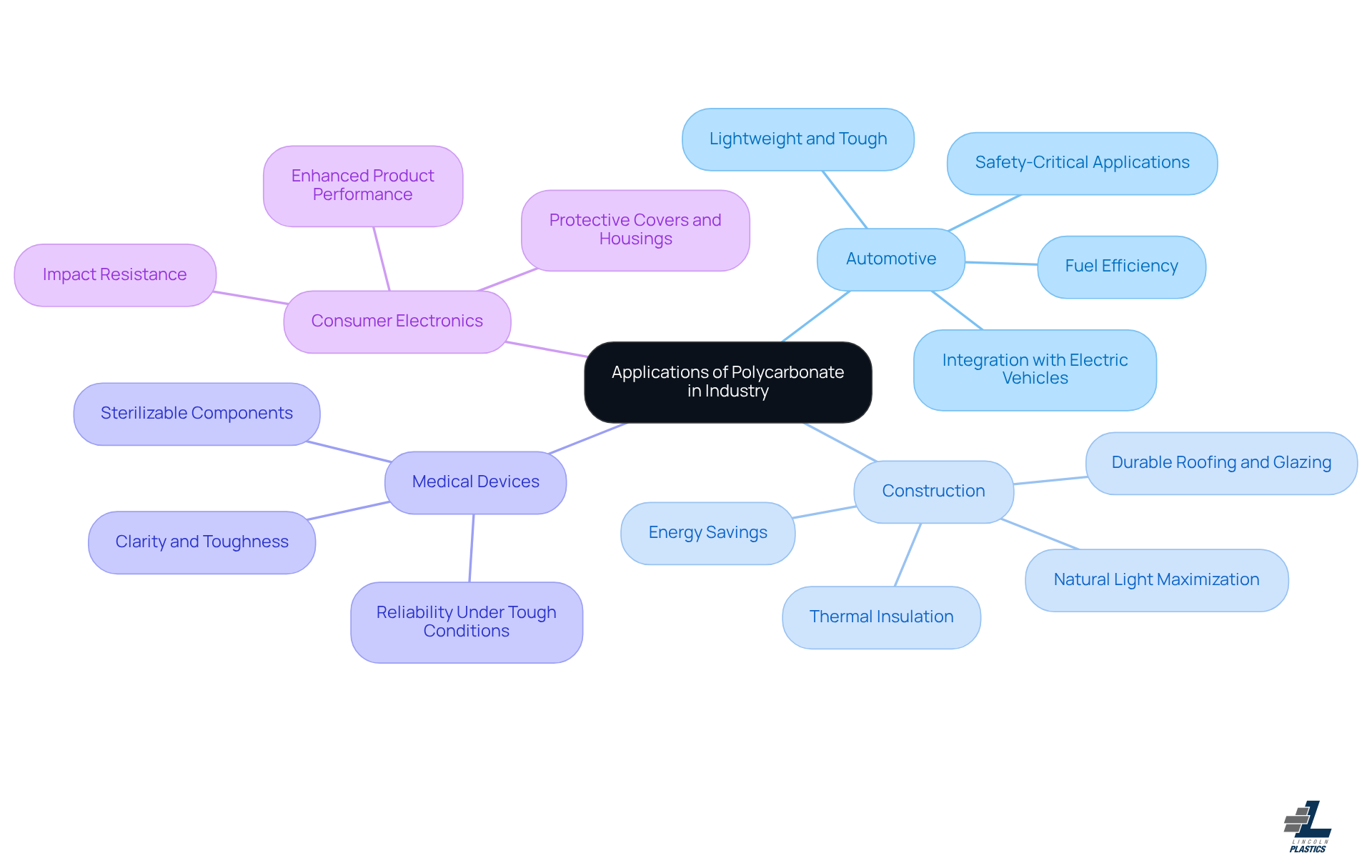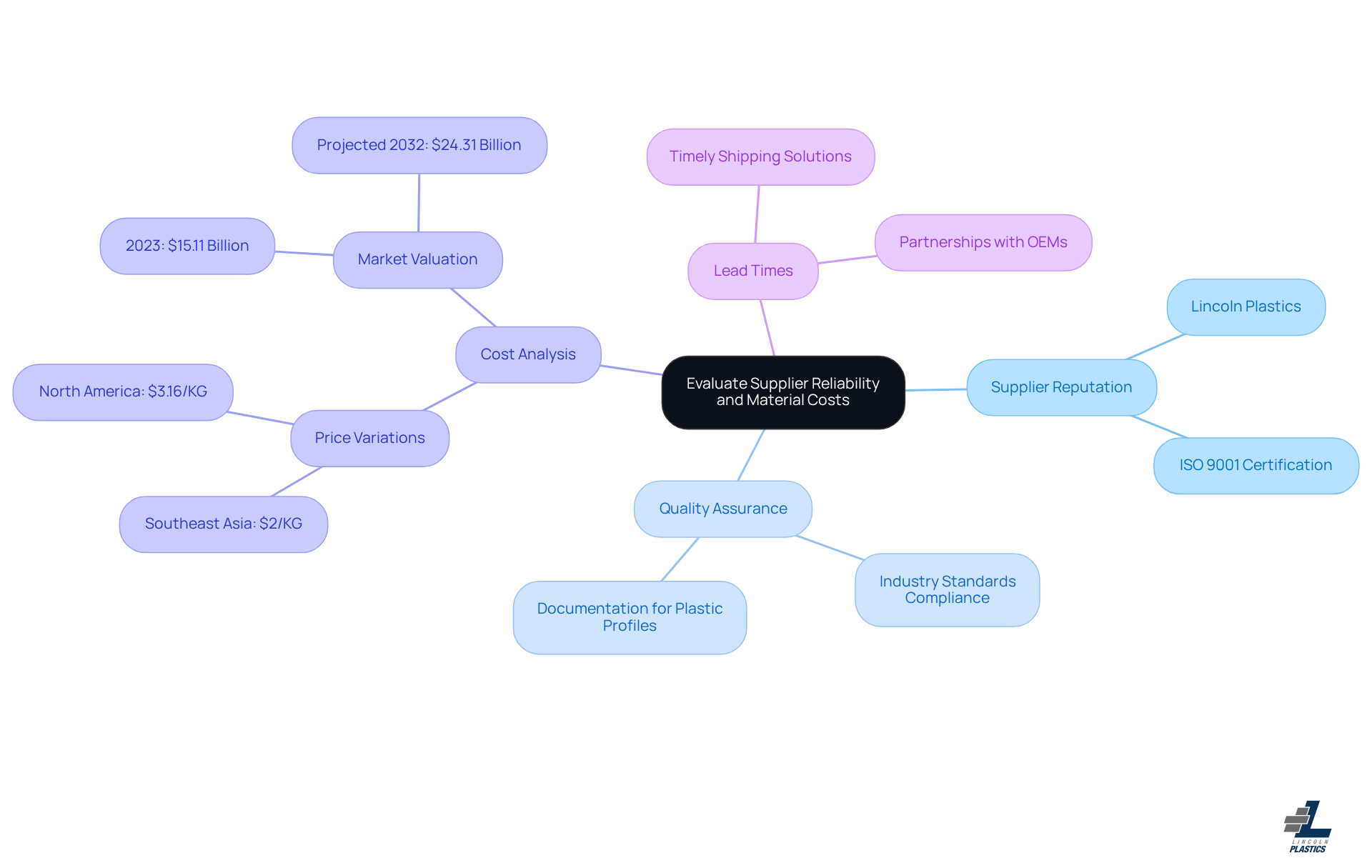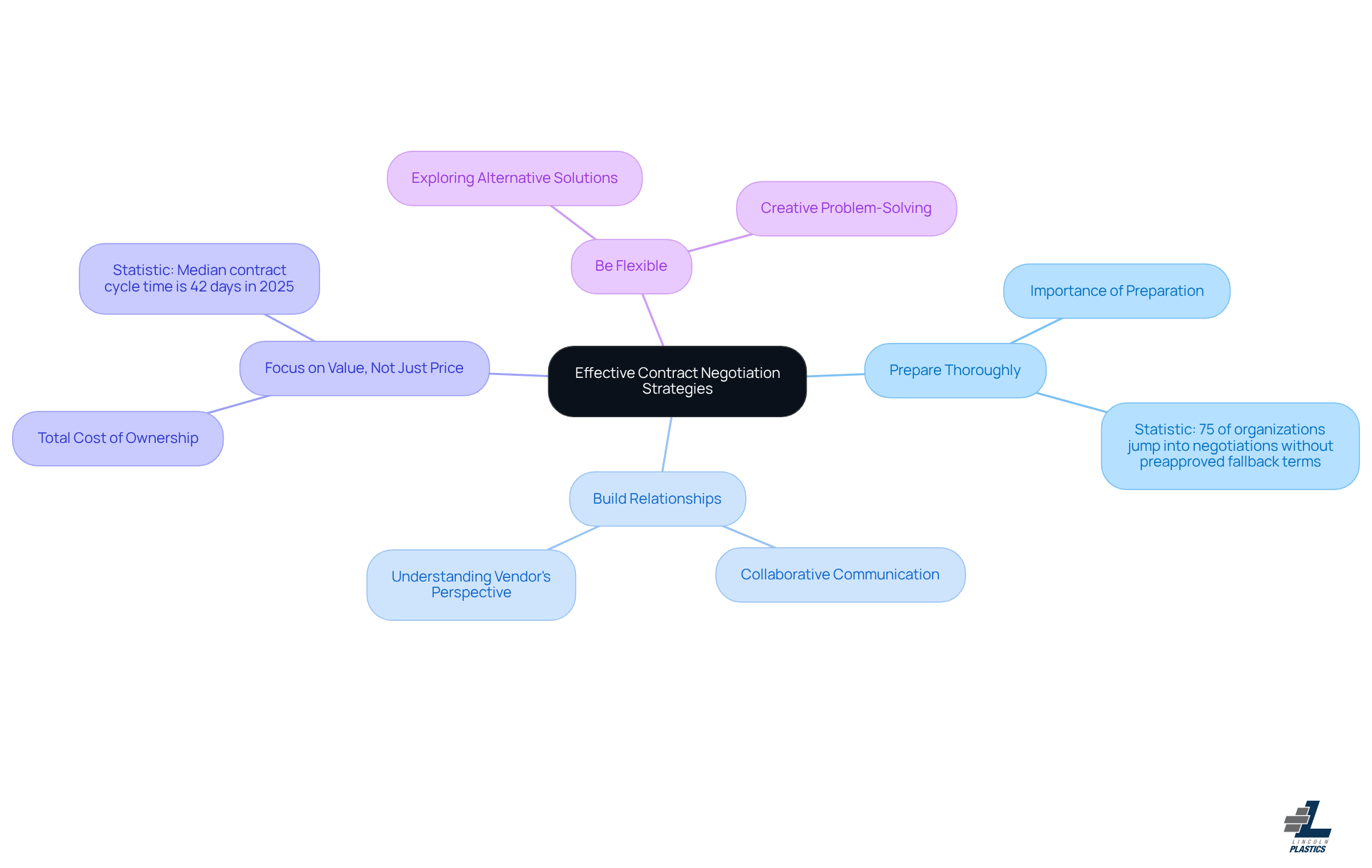
Master Polycarbonate Plastics: Best Practices for OEM Purchasing Managers
Overview
Let’s dive into the world of polycarbonate plastics! This article is all about sharing some best practices for OEM purchasing managers like you. We’ll explore the properties of polycarbonate, its applications, and how to evaluate suppliers effectively, not to mention some savvy contract negotiation strategies.
You might be wondering why polycarbonate is such a big deal. Well, it comes in various types and has a range of industrial uses. Plus, understanding the importance of supplier reliability and cost analysis can really make a difference in your procurement process.
Now, let’s talk about effective negotiation techniques. By the end of this article, you’ll be equipped with the insights needed to make informed decisions. So, are you ready to enhance your purchasing strategies? Let’s get started!
Introduction
Polycarbonate plastics are shaking things up in various industries with their impressive strength and versatility. It's no wonder that OEM purchasing managers are leaning towards them! In this article, we’ll explore the key properties, applications, and the latest advancements in polycarbonate, offering insights that could really boost your procurement strategies.
But here’s a question for you: with the market changing so quickly and so many suppliers out there, how can purchasing managers make sure they’re making smart choices that fit their operational goals? Let’s dive in and find out!
Understand Polycarbonate: Properties and Types
Polycarbonate plastics are a super versatile thermoplastic known for their incredible strength and durability, making them a go-to choice in many industries. You might be surprised to learn that it comes in several specialized types, each designed for specific applications:
- Clear Polycarbonate: This version is all about transparency, making it perfect for situations where visibility matters, like safety glazing and protective shields.
- Bullet-Resistant Polycarbonate: Built for safety and security, this type is often used in protective barriers and security windows, offering reliable defense against impacts.
- Anti-Static Polycarbonate: If you're in an environment sensitive to static electricity, this one’s essential. It’s crucial in electronics manufacturing, where static discharge can wreak havoc on sensitive components.
- Abrasion-Resistant Polycarbonate: With a surface tough enough to resist scratches and wear, this type is ideal for outdoor use, ensuring it stays durable and clear even in harsh conditions.
Now, let’s talk about some recent advancements in polycarbonate plastics that have taken performance to the next level. Researchers are developing blends that boost impact resistance and thermal insulation, making them great for energy-efficient building applications. Plus, there’s a growing trend of incorporating bio-based and recycled materials, which aligns nicely with sustainability goals in manufacturing.
Insights from materials scientists reveal that the unique combination of properties of polycarbonate plastics—such as high impact resistance, moisture resistance, and lightweight nature—makes it a top alternative to traditional materials like glass and acrylic. These features not only enhance product durability but also contribute to energy savings in applications like roofing and glazing.
Understanding these characteristics helps OEM purchasing managers select the right type of plastic for their needs, ensuring optimal performance and durability. As the market evolves, staying updated on the latest research and advancements in polycarbonate technology will be key for making smart procurement decisions. So, are you ready to dive deeper into the world of polycarbonate?

Explore Applications of Polycarbonate in Industry
Polycarbonate plastics are a super versatile material used in all sorts of industries, thanks to their amazing properties. Let’s dive into some key applications:
- Automotive: You’ll find polycarbonate popping up more and more in headlamp lenses and interior parts. Why? Because polycarbonate plastics are lightweight and tough, they provide better fuel efficiency and design flexibility for today’s electric and autonomous vehicles. Did you know it’s up to 200 times stronger than glass? That makes it a fantastic choice for safety-critical applications.
- Construction: In the construction world, polycarbonate plastics are the preferred choice for roofing and glazing. It’s durable and provides fantastic thermal insulation. Its multi-wall design traps air, acting like a natural insulator that can cut energy use by up to 30%. Just look at case studies in commercial skylights and greenhouses—they maximize natural light while keeping heat transfer to a minimum. Buildings with polycarbonate plastics can really save on operational costs through energy savings.
- Medical Devices: Medical devices require components that need to be sterilized and strong, and polycarbonate plastics are the star in this regard. Think surgical instruments and protective housings. Its clarity and toughness mean devices stay reliable under tough conditions, making it a top pick in healthcare.
- Consumer Electronics: You’ll find this material in for gadgets like smartphones and laptops. The lightweight and durable nature of polycarbonate plastics boosts product performance while offering solid protection against impacts.
At Lincoln Plastics, we work hand-in-hand with OEMs to ensure our plastic products meet all quality standards. We conduct specific evaluations for fit and function, using various check gauges to ensure everything fits just right. Plus, we can easily match colors to your Pantone specifications for consistency across manufacturers. Our robust quality system includes a dedicated quality book for each plastic profile, complete with drawings, critical in-process checks, and run documentation. By understanding these diverse applications and our commitment to precision, OEM purchasing managers can better see how this material can meet their needs and enhance their product offerings. So, how can polycarbonate work for you?

Evaluate Supplier Reliability and Material Costs
When you're looking at suppliers for polycarbonate materials, there are a few key factors you really want to keep in mind:
- Supplier Reputation: First off, take a moment to dig into the supplier's history. What do their customers say? How do they stand in the industry? A solid reputation usually means consistent quality and service. For example, Lincoln Plastics is a trusted name in manufacturing rigid profiles and is certified to the ISO 9001 standard. That’s a big deal—it shows they’re committed to high-quality processes and regulatory compliance.
- Quality Assurance: Next, you’ll want to check if the vendors meet industry standards and hold certifications like ISO 9001. This certification is crucial because it ensures that their resources meet strict performance criteria. Lincoln Plastics really emphasizes quality assurance, boasting a robust quality system that includes dedicated documentation for their plastic profiles. This ensures precision and compliance for OEMs.
- Cost Analysis: Now, let’s talk about cost. It’s important to compare pricing structures among different suppliers. Keep an eye out for bulk discounts and think about the benefits of long-term contracts to help optimize your overall costs. Did you know that the price of certain plastic materials can vary quite a bit? For instance, in Southeast Asia, it’s around $2 per kilogram, while in North America, it’s closer to $3.16 per kilogram. Plus, the global market for this type of plastic was valued at USD 15.11 billion in 2023 and is expected to hit USD 24.31 billion by 2032. That growth could definitely affect pricing strategies.
- Lead Times: Finally, consider the supplier’s ability to stick to delivery schedules. This is super important for keeping your on track. Reliable lead times can make a world of difference in your operational efficiency and project success. Lincoln Plastics partners with international clients to ensure timely shipping solutions, which helps build long-term relationships. They also work with OEMs on early-stage product ideas, offering tailored solutions that fit specific project needs.
By keeping these assessment approaches in mind, OEM purchasing managers like you can forge strong partnerships with reliable vendors such as Lincoln Plastics. Plus, by integrating insights from industry experts—such as Nikhil Kaitwade’s prediction that polycarbonate plastics will capture 65% of the global market share by 2025—you can really underscore the importance of choosing high-quality suppliers. So, what do you think? Ready to dive into the world of polycarbonate plastics?

Implement Effective Contract Negotiation Strategies
To implement effective contract negotiation strategies, OEM purchasing managers should:
- Prepare Thoroughly: It’s super important to really understand both your needs and what the supplier is offering. This preparation not only boosts your negotiation position but also sets the stage for informed discussions. Did you know that 75% of organizations jump into negotiations without preapproved fallback terms? That really shows how crucial thorough prep is!
- Build Relationships: Think about it—establishing a collaborative vibe with vendors opens up communication and leads to mutual benefits. Strong relationships can pave the way for better terms and long-lasting partnerships. As Richard Teuchler points out, professional negotiators focus on understanding the vendor's perspective, finding common ground, and solving problems together instead of treating it like a conflict.
- Focus on Value, Not Just Price: It’s all about the total cost of ownership! This includes quality, service, and reliability—not just the upfront costs. By shifting your focus this way, you can unlock better overall value and satisfaction. Fun fact: the median contract cycle time from draft to signature is 42 days in 2025. That’s a solid reason to sharpen those negotiation strategies!
- Be Flexible: Keep an open mind about exploring alternative solutions or compromises that can benefit both sides. Flexibility can lead to creative problem-solving and better negotiation outcomes. Successful organizations are moving beyond just price negotiations to forming strategic alliances with vendors, as shown in the case study 'From Transactions To Strategic Partnerships.'
By putting these strategies into practice, purchasing managers can seriously boost their negotiation outcomes, leading to more favorable contracts and stronger partnerships with vendors. The expected benefits? Enhanced supplier relationships and improved negotiation results, with structured strategies achieving up to 80% faster contract cycles. Sounds good, right?

Conclusion
Mastering the ins and outs of polycarbonate plastics is key for OEM purchasing managers looking to boost their procurement strategies. In this article, we've delved into the various properties and types of polycarbonate, showcasing its versatility across different industries—from automotive to medical devices. By getting a grip on these materials and their applications, purchasing managers can make savvy decisions that enhance product performance and sustainability.
So, what are the key takeaways? First off, evaluating supplier reliability is crucial. Understanding material costs and honing effective contract negotiation strategies can make all the difference. Think about it:
- Supplier reputation
- Quality assurance
- Lead times
These are vital for building strong partnerships with trustworthy vendors. Plus, recognizing the total cost of ownership—not just the price tag—can unlock greater value and nurture long-term relationships.
Now, let’s consider the growing market for polycarbonate plastics. This presents a fantastic opportunity for OEM purchasing managers. By staying updated on advancements and best practices in procurement, you can not only elevate your product offerings but also support sustainability goals and operational efficiency. Embracing these strategies will lead to smarter purchasing decisions and give you a competitive edge in the ever-evolving landscape of polycarbonate materials.
Frequently Asked Questions
What are polycarbonate plastics known for?
Polycarbonate plastics are known for their incredible strength and durability, making them a versatile choice in many industries.
What are the different types of polycarbonate plastics?
The main types of polycarbonate plastics include:
- Clear Polycarbonate: Ideal for visibility, used in safety glazing and protective shields.
- Bullet-Resistant Polycarbonate: Used for protective barriers and security windows, providing defense against impacts.
- Anti-Static Polycarbonate: Essential in environments sensitive to static electricity, particularly in electronics manufacturing.
- Abrasion-Resistant Polycarbonate: Designed to resist scratches and wear, suitable for outdoor use.
What recent advancements have been made in polycarbonate plastics?
Recent advancements include the development of blends that enhance impact resistance and thermal insulation, making them suitable for energy-efficient building applications. There is also a trend towards incorporating bio-based and recycled materials for sustainability.
What unique properties make polycarbonate a preferred alternative to traditional materials?
Polycarbonate plastics have high impact resistance, moisture resistance, and a lightweight nature, making them a top alternative to traditional materials like glass and acrylic. These features enhance product durability and contribute to energy savings in applications like roofing and glazing.
Why is it important for OEM purchasing managers to understand polycarbonate characteristics?
Understanding the characteristics of polycarbonate helps OEM purchasing managers select the right type of plastic for their needs, ensuring optimal performance and durability.
How can staying updated on polycarbonate technology impact procurement decisions?
Staying updated on the latest research and advancements in polycarbonate technology is key for making informed and smart procurement decisions in a rapidly evolving market.
List of Sources
- Understand Polycarbonate: Properties and Types
- Global Polycarbonate Sheet Market Size & Forecast, 2025-2032 (https://coherentmarketinsights.com/industry-reports/global-polycarbonate-sheet-market)
- US Polycarbonate Manufacturing Gets Major Boost (https://plasticstoday.com/extrusion-film-sheet/us-polycarbonate-manufacturing-gets-major-boost)
- Polycarbonate Market Size, Share, Trends, Growth Report [2032] (https://fortunebusinessinsights.com/polycarbonate-market-108509)
- North America Polycarbonate Sheets Market Forecast Report 2025-2030, with Key Player Profiles for Covestro, CS Hyde, Gallina, San Diego Plastics, Palram, Stabilit Suisse, Lyon Plastic, Tileron & more (https://uk.finance.yahoo.com/news/north-america-polycarbonate-sheets-market-112700906.html)
- The Future of Polycarbonate: Trends to Watch in 2025 -UNQ (https://unqpc.com/the-future-of-polycarbonate-trends-to-watch-in-2025)
- Explore Applications of Polycarbonate in Industry
- The Future of Polycarbonate: Innovations, Applications, and Sustainability Trends - Jordan Panels (https://jordanpanels.com/the-future-of-polycarbonate-innovations-applications-and-sustainability-trends)
- Automotive Polycarbonate Glazing Market Size, Growth and Forecast 2032 (https://credenceresearch.com/report/automotive-polycarbonate-glazing-market)
- Why Polycarbonate Sheets Are the Latest Trend in Building Design (https://homeworlddesign.com/why-polycarbonate-sheets-are-the-latest-trend-in-building-design)
- Polycarbonate in Automotive Applications | Facts About BPA (https://factsaboutbpa.org/blog/polycarbonate-in-automotive-applications)
- 24 Chemical Research (https://24chemicalresearch.com/blog/13848/polycarbonate-plastics-market-key-trends-2025)
- Evaluate Supplier Reliability and Material Costs
- US Polycarbonate Manufacturing Gets Major Boost (https://plasticstoday.com/extrusion-film-sheet/us-polycarbonate-manufacturing-gets-major-boost)
- Polycarbonate Resins Market 2025 to 2035 (https://futuremarketinsights.com/reports/polycarbonate-resins-market)
- Covestro Expands Production in Ohio (https://covestro.com/press/covestro-expands-production-in-ohio)
- Polycarbonate price index - businessanalytiq (https://businessanalytiq.com/procurementanalytics/index/polycarbonate-price-index)
- Polycarbonate Market Size, Share, Trends, Growth Report [2032] (https://fortunebusinessinsights.com/polycarbonate-market-108509)
- Implement Effective Contract Negotiation Strategies
- 53 Contract Management Statistics Ahead of 2025 (https://contractsafe.com/blog/contract-management-statistics-2025)
- Negotiation Statistics 2025 — 60 Key Figures (https://procurementtactics.com/negotiation-statistics)
- Supplier Negotiation Mastery: From Basics to Advanced Tactics (https://kodiakhub.com/blog/supplier-negotiation)
- Negotiation Quotes — 25 Legendary Quotes Full of Wisdom (https://procurementtactics.com/negotiation-quotes)


